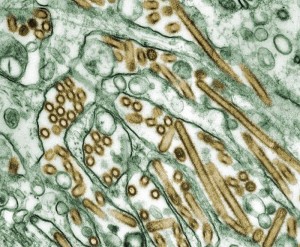The Epidemiology and Disease Control Division of the Nepal Ministry of Health and Population confirmed Thursday the first human fatality due to H5N1 avian influenza infection.

According to health officials, the victim was a 21-year-old man from Kavrepalanchok district.
The Himalayan Times says the individual died on March 29 after having contracted the flu. Laboratory tests, which were received on April 30, was found to be H5N1 influenza positive. The health officials who had diagnosed bird flu as the cause of the patient’s death had sent the patient’s sample to Japan for further tests.
According to the World Health Organization (WHO), H5N1 is a type of influenza virus that causes a highly infectious, severe respiratory disease in birds called avian influenza (or “bird flu”). Human cases of H5N1 avian influenza occur occasionally, but it is difficult to transmit the infection from person to person. When people do become infected, the mortality rate is about 60%.
 Almost all cases of H5N1 infection in people have been associated with close contact with infected live or dead birds, or H5N1-contaminated environments. The virus does not infect humans easily, and spread from person to person appears to be unusual.
Almost all cases of H5N1 infection in people have been associated with close contact with infected live or dead birds, or H5N1-contaminated environments. The virus does not infect humans easily, and spread from person to person appears to be unusual.
The last reported human H5N1 AI cases were reported in 2017 in Indonesia and Egypt. Prior to this case, since 2003, a total of 860 laboratory-confirmed cases of human infection with avian influenza A(H5N1) virus, including 454 deaths, have been reported to WHO from 16 countries.
- New York City measles outbreak tops 400 cases
- Measles case onboard Scientology cruise ship, quarantined in St. Lucia
- Mayaro virus situation in the Americas 2019 to date: Peru, Ecuador
- Tennessee measles tally now at 5
- White-nose syndrome: Vaccination may reduce the impact of destructive fungal disease
- Denmark reports Yersinia enterocolitica outbreak
- Dengue vaccine, Dengvaxia receives FDA nod for endemic regions



Has there been any significant impact on Nepal’s poultry industry due to this avian influenza case? Greeting Telkom University